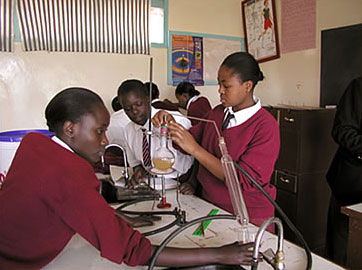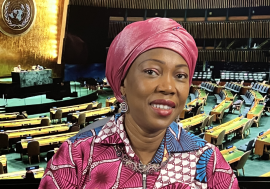Africa aims for a scientific revolution
Africa aims for a scientific revolution
 Science class in Nairobi, Kenya: African governments have pledged to promote the study of science and technology.
Science class in Nairobi, Kenya: African governments have pledged to promote the study of science and technology.African leaders have pledged to devote more resources to the development of science and technology, an area deemed vital for economic development, yet long neglected and poorly funded in many countries. At a January 2007 summit of the continent’s political body, the African Union, heads of state “strongly urged” all AU countries to allocate at least 1 per cent of their gross domestic product to research and development by 2020. They also pledged to revitalize African universities — many of which have declined due to dwindling support over the last few decades — and to promote the study of science and technology by young people.
Declaring 2007 the year of science and technology, the leaders, who met in Addis Ababa, Ethiopia, agreed to a series of other initiatives. These included establishing a pan-African intellectual property organization to help protect indigenous innovations and starting on a 20-year strategy to promote cooperation among states on research in biotechnology. The programmes would be run by the continent’s various regional economic organizations.
The decisions build on and enhance Africa’s Science and Technology Consolidated Plan of Action. The plan was launched in 2005 by the AU and the secretariat of the New Partnership for Africa’s Development (NEPAD), the continent’s overall blueprint for economic and political advancement. The science plan is intended to develop an African system of research and technological innovation to support AU and NEPAD programmes in areas such as agriculture, the environment, infrastructure, industry and education. It envisions a science and technology sector that is inclusive — drawing on knowledge and ideas from rural dwellers (custodians of indigenous knowledge), students, academic researchers and representatives of industry and government.
 Garment factory in Botswana: Modern technological processes are key to improving industrial productivity.
Garment factory in Botswana: Modern technological processes are key to improving industrial productivity.The plan includes research projects in 12 “clusters,” each of which has a specific purpose: these include conserving and sustainably using biodiversity, developing biotechnology, securing and using Africa’s indigenous knowledge, building sustainable water and energy resources, combating drought and desertification, building engineering capacity for manufacturing and adopting new information technologies. However, the African leaders meeting in Addis Ababa did not reach a consensus on how to finance the plan, which the AU initially estimated would cost $158 mn over five years.
The plan “visualizes the possibility of an Africa that is free of poverty and well integrated into the global economy,” says South African Science and Technology Minister Mosibudi Mangena. “Aspirations of the plan include, among others, addressing Africa’s local needs, building strong African institutions geared towards knowledge production and application, cultivating Africa’s skills pool, developing an enabling policy environment and embracing, nurturing and harvesting regional diversity.”
The plan reflects a growing sense of urgency in Africa about using science and technology to help spur industrial and agricultural productivity, ensure food security, control diseases, provide clean water and preserve the environment.
Science-led development
However, most African countries have yet to transform their political pledges into feasible programmes for science-led development. Sub-Saharan Africa contributes about 2.3 per cent of world gross domestic product but is responsible for only 0.4 per cent of global expenditure in research and development (R&D). With 13.4 per cent of the world’s population, the continent is home to only 1.1 per cent of the world’s scientific researchers. It has about one scientist or engineer per 10,000 people, compared with 20–50 in industrial nations.
Over the years, the science and technology gap between Africa and the rest of the world has grown. While other regions constantly upgrade their technologies, Africa is failing to keep up. Some economists feel that this widening gap is partly responsible for the continent’s underdevelopment.
 Students at the University of Zambia: For African countriesto develop their scientific research capacities, more resources are needed for higher education.
Students at the University of Zambia: For African countriesto develop their scientific research capacities, more resources are needed for higher education.The most serious challenges hindering the development of science and technology in Africa include a steady decline in funding, brain drain (flight of skilled personnel to other areas), inadequate infrastructure, insufficient levels of literacy and a shortage of women in science. Also, links between industry and science and technology institutions are weak. As a result, research findings are often not used by local industries, particularly small and medium-sized enterprises.
“Declaring the year for science innovations is an important beginning, but will require strong backing so that good showcases and practical scientific work is brought to the people’s attention,” says Mr. Stephen Agong, director of the Nairobi-based African Academy of Sciences. And, he adds, it will take time “for governments to plan, commit and allocate funds to support this cause.”
In the meantime, people in communities across Africa continue to innovate and to adapt technologies to meet their own local needs. For example, in Mali, villagers developed a hand-operated device to shell groundnuts. Made out of concrete, wood and scrap metal, it costs the equivalent of US$10. Unlike more expensive shellers that require more than one person to operate, it can be run by a single person and has a life expectancy of about 25 years. One machine can meet the needs of a village of 2,000 people.
Challenges
In many countries, national policies to promote science and technology are outdated, notes Mr. Abdoulaye Janneh, executive secretary of the Addis Ababa-based UN Economic Commission for Africa (ECA). The quality of science and engineering education is also declining, in part due to a lack of money and of infrastructure such as state-of-the-art labs and technology centres. Nearly 30 years ago, in 1980, African leaders’ Lagos Plan of Action called for countries to allocate at least 1 per cent of gross domestic product to R&D, to help to spur the continent’s development. But after all this time, “many of our countries devote considerably lower funding” to that end, notes Mr. Janneh.
The AU acknowledges that the lag is not primarily the result of limited funding, but of a lack of appreciation for the value of such investments. The “return on the investment in science and technology is not appreciated by policy makers and even African industry,” the AU reports.
When African leaders met in Addis Ababa in January, many still did not have a full grasp of the issues, admitted Mozambican President Armando Guebuza. “Even during this summit, we had to call upon the experts to point out the importance of science and technology, so that even those among us who have not yet understood very well how imperative it is to develop science on our continent can now also accept this task,” he said. “It must be made clear that without the commitment of the leadership, there can be no scientific and technological development on our continent.”
New impetus
Over the last few years, there have been signs of a shift towards exploring the potential of science and technology for development, both globally and in the region. In 2003, the final document of the World Summit on Sustainable Development held in Johannesburg, South Africa, highlighted the importance of science and technology in attaining the development goals of poor nations. Science, the report stressed, can help poor countries resolve problems such as energy deficiency, food insecurity, environmental degradation, diseases and water scarcity. Science and technology can also boost industrial productivity. In East Asia, the report observed, a transfer of technology from industrial nations, inflow of foreign investment and sizeable spending on education were at least partly responsible for the industrialization of several countries.
According to the UN Educational, Scientific and Cultural Organization (UNESCO), a relatively small additional investment in countries such as South Africa, Côte d’Ivoire, Kenya and Zimbabwe, which already have a relatively sophisticated science and technology base, could establish world-class facilities to advance the region as a whole. In Taiwan and South Korea, investment in local research institutes enabled those countries to develop infrastructure, helped local firms develop their own technologies and generated a large number of experienced researchers, who later played key roles in R&D activities.
While the challenges may appear daunting, the continent cannot afford to waste any more time. It should begin a major drive to train and deploy large numbers of scientists, engineers and technicians, says ECA Executive Secretary Janneh. African states also need to establish strong links between technology-based industry, academia and government to ensure that the sector’s contribution is reflected in national policies.
Surmountable challenges
At the moment, the picture varies widely across the continent, with some countries far ahead of others in their science and technology programmes. Nigeria is one of these leaders. Since returning to civilian rule in 1999, the country has invested heavily in the sector. In 2003 it launched a micro-satellite to monitor the environment and provide information for infrastructure development. The following year the government asked UNESCO to help it develop a national science and technology plan. The project involved analyses of government policies and spending in the sector and a review of the curricula content and capacity in the country’s 75 research institutes, 55 universities and 44 polytechnics. In 2006 the country approved a $5 bn endowment fund for science and technology development, drawn from oil export revenues and supplemented by funds from donors and private companies.
Egypt and South Africa have also attained significant success, notes UNESCO’s Science Report 2005. South Africa, which in 2002 spent $3.1 bn on research and development (equivalent to 0.7 per cent of its GDP), has advanced science research capabilities in aeronautics, nuclear engineering, chemistry, metallurgy, agriculture and medicine. Egypt leads North Africa in chemistry and engineering. In 2000 it spent $400 mn on research and development.
Across Africa, the need is great for scientific answers to the continent’s many problems. UNESCO reports that in sub-Saharan Africa, almost 92 per cent of the rural population and 48 per cent of those in urban areas do not have modern energy services. Connecting them to the national grid is prohibitively expensive for many countries. For years now, development planners have touted the advantages of solar technology as an alternative energy source, but progress in adopting it remains slow in many countries. Over the next 20 years the continent is expected to lose half of its water reservoir capacity due to silting and poor land management. As a result, many countries will need to invest in cost-effective ways of tapping and distributing groundwater. A June 2006 conference of African scientists and decision-makers in Tunisia recommended that the region focus its research attention on this critical area.
To assist Africa’s less industrialized countries, the UN Department of Economic and Social Affairs is currently running a project to promote emerging technologies, such as information and communication technologies, biotechnologies, nanotechnologies and fuel technologies. In 2003, as part of the programme, the UN and a number of African governments, private companies and academics recommended setting up science and technology parks. Out of an initial group of eight countries, Ghana and Senegal were selected to begin work on such parks — state-of-the-art premises for technology companies offering production, assembly, research, technical development and office facilities.
Once complete, the park in Senegal will house computer software and hardware companies, data processing centres and multimedia industries such as music and video production houses. It will also have pharmaceutical and biotechnology labs. It will bring together enterprises that use advanced technologies intensively, says Mr. Abdou Salam Sall of Chiekh Anta Diop University in Dakar, Senegal. The government aims to create 20,000 jobs within the first five years of operation of the park, he says.
“Many emerging economies currently lack the capacity to meet their needs for technology transfers in support of sustainable development,” notes Mr. Sall. But India shows that things can change: the country has succeeded in developing science and technology sectors through such parks, which bring together researchers, technology experts, inventors and entrepreneurs.
A case for higher education
While it may appear obvious that countries that neglect higher education cannot do well in science and technology, many African countries have been doing just that. In the 1980s most African countries adopted structural adjustment programmes that emphasized cuts in public spending. Under the programmes, they reduced education budgets, eliminated subsidies for students and devalued currencies, which raised the cost of imported educational materials.
When donor agencies later recognized the need to renew funding for education, they shifted their earlier emphasis on tertiary education, which they now saw as catering to the elite few, towards primary education. The World Bank and other donors argued that investment in primary education yielded higher returns to society as a whole, while tertiary education produced returns only for their individual graduates. “Because of a belief that primary and secondary schooling are more important than tertiary education for poverty reduction, the international development community encouraged African governments’ relative neglect of higher education,” the World Bank later acknowledged in a 2006 study.
From 1985 to 1989, only 17 per cent of the Bank’s worldwide education spending went towards higher education. It declined to 7 per cent from 1995 to 1999, noted the study, Higher Education and Economic Development in Africa. Initially, after most African countries achieved their independence in the 1960s, the number of tertiary institutions and students in Africa surged in response to the demand for skilled personnel to run the new states. While there were only 13 universities in sub-Saharan Africa in 1960, by 2002 there were about 300. However, funding failed to keep up with that expansion. Today, many of Africa’s universities and colleges are inadequately staffed and ill equipped. Their quality of education has declined. Many countries struggle to maintain even low enrolment levels, and the academic research output in the region is among the lowest in the world.
Only recently have African countries and their donor partners begun to reconsider the role of tertiary education. “Knowledge-based competition within a globalizing economy is prompting a fresh consideration of the role of higher education in development and growth,” notes the World Bank’s education advisor for the Africa region, Jee-Peng Tan. “Previously it was often viewed as an expensive and inefficient public service that largely benefited the wealthy and privileged.”
One possible channel through which higher education can enhance economic development is through “technological leapfrogging.” This phenomenon occurs when countries skip intermediary stages in technological development to higher levels that have already been developed elsewhere. “In a knowledge economy, tertiary education can help economies gain ground on more technologically advanced societies, as graduates are likely to be more aware of and better able to use new technologies,” notes the World Bank study on higher education in Africa.
Forging ahead
Rwandan President Paul Kagame poses the question now facing many African countries: “Where are we headed, and what needs to be done to give science and technology their due weight in our development processes?”
In a 2005 report, the Commission for Africa, a 17-member panel of experts convened by the UK’s then Prime Minister Tony Blair, recommended that Africa promote science and technology through partnerships with other developing countries such as Brazil and India, international organizations such as the World Bank and donor nations. The commission called for the development of centres and networks of excellence, in collaboration with institutions of higher learning in other countries. The Blair Commission recommended that the international community provide $3 bn over 10 years for the development of such African centres of excellence. Sub-Saharan Africa already has 10 academies of science — in Cameroon, Egypt, Ghana, Kenya, Madagascar, Nigeria, Senegal, South Africa, Uganda and Zimbabwe.
“There are certain scientific fields for which we will have to create new institutes, and others for which we can nurture existing ones,” says Mr. John Mugabe, advisor on science and technology to NEPAD. “In the area of biotechnology, for example, African leaders have decided to use existing national, regional and international institutes. In these cases, nodes and hubs of networks have been designated, and research and training activities are being undertaken in these institutes.” He cites two examples: North Africa, with its relative strength in pharmaceutical biotechnology, would be responsible for that area. East Africa, where the International Institute for Livestock Research is based, would take on the responsibility for biotechnology research on breeding and livestock feed.
The New York-based UN Millennium Project recommended that the international community either support under-funded research areas in Africa directly or fund international teams to conduct world-class research in relevant fields. International donors could also support international research networks that work closely with developing countries, such as the Consultative Group on International Agricultural Research. Established in 1972, the group is best known for the contributions of its affiliated institutes to developing new crop varieties in developing countries, in collaboration with local researchers.
“Agricultural production is an area in which global research efforts make eminent sense,” the Millennium Project reports. “Research on food crops for domestic consumption was long neglected in developing countries, where the emphasis of colonial powers was on exports.” In this area, research in one country can often benefit other countries, especially if promoted by a multinational research group, such as the West Africa Rice Development Association, an 11-country intergovernmental rice research centre.
African governments themselves need to come up with effective policies. The ECA says that policies will work if they are developed in consultation with all economic operators and stakeholders. They should also be incorporated into national legislation and provide incentives for investors. In contrast, if governments are passive or promote technologies that have little relevance to private partners, the result will most likely be failure.
While many good intentions have been expressed in Africa, says President Kagame, “intentions are not enough to enable science and technology to become a developmental resource. It is action on the ground that will make the difference.”















